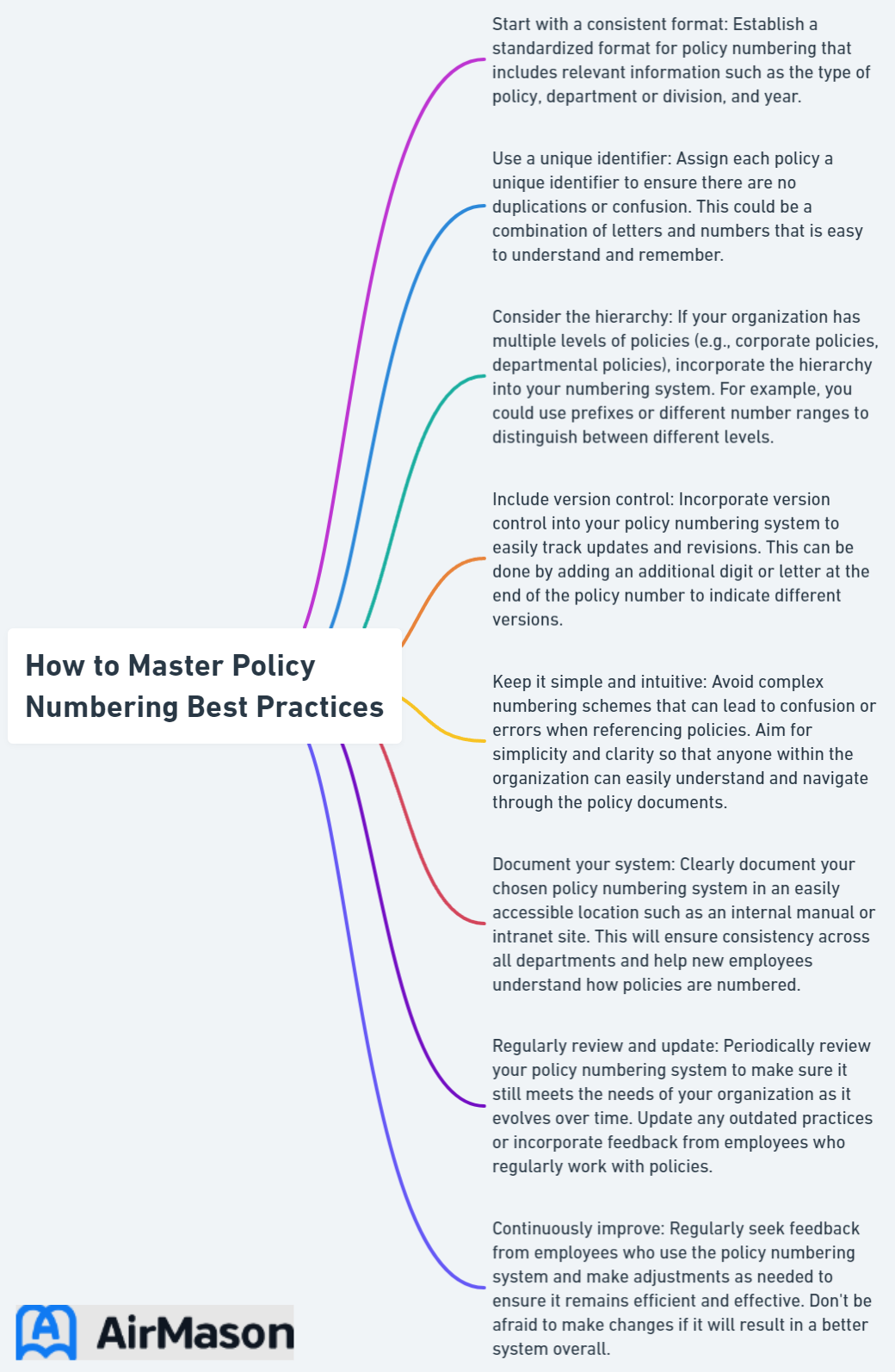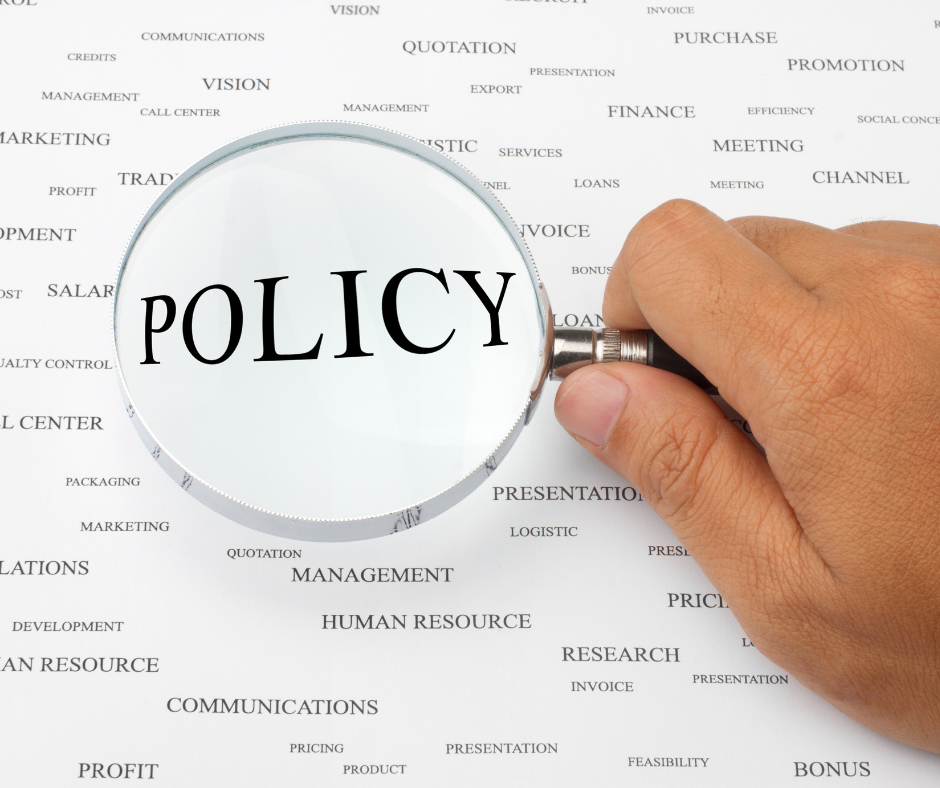
Imagine working in an organization with a myriad of policies, but without a clear and consistent policy numbering system. It’s like searching for a needle in a haystack when trying to locate or reference a specific policy. Mastering policy numbering best practices can transform this chaos into a well-organized and efficient system, ensuring that policies are easily identifiable, well-structured, and consistent across the organization. In this blog post, we’ll delve into the importance of policy numbering systems, discuss practical tips for designing and implementing such systems, and examine real-life examples to apply these insights to your own organization.
Key Takeaways
- A policy numbering system is essential for uniformity, straightforward identification of policies and a smooth approval process.
- Organization of the policy numbering system facilitates identification, retrieval, consistency and compliance with industry trends.
- Designing an effective policy numbering system involves meaningful numbers/labels, hierarchical structure and automated systems to ensure user friendliness.
How to Write a Policy
When considering how to write a policy, it is essential to begin with a clear understanding of the purpose and scope of the document. Start by outlining the objectives you aim to achieve and the specific guidelines that need to be established. Clearly articulate the key principles and rules in a comprehensive manner, ensuring that the language is concise and easily understandable. Incorporate input from relevant stakeholders to enhance the policy’s effectiveness and legitimacy. Regularly review and update the policy to align with changing circumstances or organizational needs, fostering a dynamic and adaptive framework. By following these steps, you can create a well-crafted policy that serves its intended purpose and stands the test of time.
The Importance of a Policy Numbering System
Every organization needs a policy numbering system to maintain order and clarity within their policies. Its intent is to guarantee uniformity and straightforward identification of policies, which ultimately leads to a smooth approval process. With a logical and consistent numbering system, users can promptly and accurately identify the policy they require, gaining access to the pertinent information without delay.
To create an effective policy, follow these guidelines:
- Select a precise title for the policy.
- Incorporate a policy statement that clearly outlines the purpose and scope of the policy.
- Define any particular terms or concepts used in the policy.
- Ensure consistent formatting and accessibility throughout the document.
By following these guidelines and implementing a policy numbering system, you can create policies that are easy to navigate and understand, promoting efficiency and effectiveness within your organization.
Assigning a number to each policy after determining its purpose is significant, as it facilitates an orderly structure that is comprehensible and easier to adhere to. This enables organizations to effectively manage their own policies. The importance of a policy numbering system extends to various aspects, such as consistency, easy identification, and organization, which we will explore further in the following subsections.

Consistency
A uniform approach throughout the organization is guaranteed by maintaining consistency in policy numbering, which is particularly important for campus wide policies sa in educational institutions. This consistency extends to various elements within a policy document, such as the revisions section, which encompasses an audit trail of policy adoption and revisions, adoption date, revision information, and brief notes elucidating each revision date. Including a compliance and consequences section that outlines the repercussions of policy infringements is vital and the organization’s measures to guarantee compliance, such as reporting to higher authorities like a vice president.
Moreover, consistency in policy numbering ensures clear delineation of responsibilities, preventing uncertainty and guaranteeing accountability. A policy statement succinctly articulates the primary principles and regulations of the policy, ensuring clarity and consistency.
Ultimately, having clearly-defined and consistent policies within a company creates a positive work environment by reducing misunderstandings and conflicts, improving organizational efficiency, and constructing a reputable brand image.
Easy Identification
A distinct numbering system for policies can be transformative as it facilitates easy identification of policies, enabling employees to quickly locate relevant information. Examples of clear policy numbering systems that facilitate easy identification include Intelligent part numbering system, SOP numbering system, and Paragraph numbering system. A clear policy numbering system has a positive effect on employee efficiency and productivity, as it ensures clarity and consistency in understanding and adhering to policies, and promotes effective communication and implementation of policies.
However, there are common missteps in policy identification that can impede employees’ ability to locate pertinent information, such as:
- Outdated or irrelevant policies
- Inadequate communication
- Ambiguous policy titles
- Inconsistent language in policies
By employing an intelligible and consistent policy numbering system, organizations can overcome these challenges and ensure that policies are easily accessible and comprehensible to all employees.
Organization
Streamlining policy management and retrieval is possible by organizing policy numbering systems, making it more straightforward to recognize and access policies, guarantee uniformity and standardization, regulate compliance and risk, manage documents and versions, and encourage collaboration and communication. Implementing policy numbering systems offers several advantages, such as facilitating identification and retrieval, ensuring consistency and standardization, aiding compliance and risk management, providing document control and versioning, and encouraging collaboration and communication.
Regularly reviewing and updating policies is highly important, as they allow employees to stay abreast of industry trends and enable the organization to remain agile in the face of changing circumstances. Furthermore, policies play a crucial role in constructing a reputable brand image, showcasing employees’ dedication to ethical practices, data privacy, and safety, thus engendering trust with customers and stakeholders.
Designing a Policy Numbering System
To design a policy numbering system, one must employ meaningful numbers and labels, ensuring that the numbering system is comprehensible without requiring a thorough perusal of policies. A hierarchical structure with multiple tiers of categories and subcategories enhances the identification of policies associated with each category and facilitates the addition of new policies or alteration of existing ones. Employing an automated system to assign policy numbers can also be advantageous, as it can expedite the process and decrease mistakes.
Having established the essentials of a policy numbering system, we can delve more deeply into its key elements, categorization, and the levels of hierarchy.
Key Elements
The essential components of a policy numbering system consist of policy type, department, and a distinct identifier. Policies are categorized and organized based on their type or purpose by the policy type, helping stakeholders easily identify and locate policies.
The department factor within a policy numbering system classifies policies according to the department or division to which they belong, ensuring the organization and identification of policies based on their corresponding departments.
Lastly, a unique identifier is a specific number assigned or code assigned to a policy that distinguishes it from other policies, guaranteeing that each policy is easily identifiable and avoids confusion or duplication.
Categorization
Policy categorization entails organizing policies according to their objective, department, or function. Categorization in policy numbering facilitates policy management by providing a well-structured and organized system for classifying policies, allowing for simplified identification and retrieval of specific policies within a large collection. Categorization streamlines policy management processes, increases efficiency, and ensures consistency in policy implementation and enforcement.
Policy categorization between different industries or sectors can vary based on factors such as industry classification systems and the regulatory requirements specific to each industry. Larger industries with diverse sub-sectors may require more specific and tailored policies to cater to their unique requirements.
Levels of Hierarchy
By providing a structured and organized framework for categorizing and assigning policy numbers, hierarchy plays a vital role in a policy numbering system. It facilitates flexibility and ease of management through the utilization of multiple levels of categories or levels of hierarchy, organizing policies based on their subject matter, department, or any other pertinent criteria.
A hierarchical policy numbering system facilitates the identification of relationships between policies by supplying a well-defined and organized structure. Every policy is allocated a distinct number in accordance with its location within the hierarchy, such as volume and chapter. This numbering system permits convenient categorization and arrangement of policies, making it easier to recognize relationships and dependencies between them.
Examples of hierarchical structures in policy numbering include enterprise-level policies, department-level policies, operational-level policies, and sub-policies.
Implementing a Policy Numbering System
The initial step in implementing a new policy numbering system is to examine existing policies for any discrepancies or gaps in the current numbering system. Employing a standard format for policy numbers ensures uniformity across the organization, making it easier for stakeholders to locate and access the required information.
Once a numbering system is designed, the next steps involve reviewing existing policies, developing a plan for implementation, and training employees on the new system.
Examples of Policy Statements
When crafting effective policies for an organization, understanding clear and concise examples of policy statements is crucial. Examples of policy statements provide tangible illustrations of how to communicate rules, guidelines, and expectations. Organizations often use examples of policy statements to establish a framework for decision-making, ensuring consistency and adherence to standards. By exploring diverse examples of policy statements, businesses can tailor their own policies to reflect their unique values and goals. Whether it’s in the realm of employee conduct, data security, or environmental sustainability, having concrete examples of policy statements can serve as a valuable reference for developing robust and comprehensive policies.
Review Existing Policies
The initial step in executing a new policy numbering system is to examine existing policies for any discrepancies or absences in the current numbering system. By identifying gaps and inconsistencies in a policy numbering system, organizations can ensure that all policies have current versions.
The process of identifying gaps and inconsistencies involves:
- Examining the present policies and their associated policy numbers
- Scanning for any absent policy numbers or gaps in the sequence of policy numbers
- Ensuring that each policy is correctly labeled and allocated
Regularly reviewing policies is critical to guarantee their pertinence and modernity, facilitating the mitigation of risks, the enhancement of policy efficacy, and the recording of alterations through an organized numbering system. Conducting a policy review ensures that these objectives are met effectively.
Develop a Plan
Developing a plan that incorporates types and categories into the system is a crucial step in effectively implementing a policy numbering system, ensuring that it meets the needs and requirements of the organization. The optimal way to implement a numbering format or structure that is intuitive and easy to comprehend is to utilize a two-level numbering system, incorporating a prefix and a suffix, with the prefix symbolizing the policy type and the suffix symbolizing the policy number.
For instance, a university may employ the prefix “AC” for academic policies and the suffix “001” for the first policy in that category. This hierarchical structure facilitates the organization and categorization of policies based on their level of importance or scope.
Train Employees
To ensure understanding and compliance within the organization, it’s necessary to train employees on the new policy numbering system. Several resources are available to assist employees in comprehending a new policy numbering system, including:
- Charts and visual representations
- Documented policies and procedures
- Online training
- Real-life examples
It is vital to communicate the importance of a policy numbering system to employees.
- Articulate the purpose and advantages of having a policy numbering system.
- Provide training and resources.
- Notify all employees of the numbering system once it is implemented.
- Be transparent and open to feedback.
Maintaining and Updating Your Policy Numbering System

Regularly reviewing and updating policies is a part of maintaining an up-to-date policy numbering system, ensuring that they remain relevant and reflect any changes in the organization or industry. When policies are revised, it is essential to update the policy numbering system accordingly, documenting the alterations and ensuring that all policies have current versions.
This section will focus on the importance of regularly reviewing policies, revising policies as needed, and communicating changes to the policy numbering system to all employees and stakeholders.
Regularly Reviewing Policies
The importance of regularly reviewing policies cannot be overstated, as it enables organizations to ensure that policies are current, consistent, and in agreement with regulations, industry standards, and organizational modifications. Indicators that a policy requires revision or updating include alterations in the external environment, feedback from stakeholders, incompatible or antiquated practices, performance issues or discrepancies, legal or compliance requirements, and insights derived from incidents or audits.
By regularly reviewing policies and addressing these indicators, organizations can maintain an effective policy numbering system that supports risk management and policy efficacy.
Revising Policies
Various factors often lead organizations to revise their policies, such as:
- Changes in workplace habits and behaviors
- Divergence from established practices
- Congruence with mission, vision, and strategy
- Technological advancements
- Human behavioral changes
When revised policies are implemented, it is crucial to update the policy numbering system accordingly, maintaining the original copies and organizing the revised versions with a numbering system, while keeping track of the revision history.
This process ensures the organization’s policy numbering system remains consistent, accurate, and relevant while reflecting any changes or updates to the policies themselves.
Communicating Changes
For streamlining the process, communicating changes to the policy numbering system is vital, notifying personnel, diminishing customer dissatisfaction, aiding stakeholders in comprehending and adjusting, preventing costly oversights, and supporting change strategies. Available methods of communication for disseminating changes in policy numbering systems include email notifications, online portals, mobile applications, website updates, and chatbots/virtual assistants.
To ensure all employees understand and adjust to changes in policy numbering systems, it is essential for human resources to:
- Structure information logically
- Be open
- Provide training if necessary
- Invite feedback
- Utilize face-to-face communication when possible.
Real-Life Examples of Policy Numbering Systems

This section will examine real-life examples of policy numbering systems in both university and corporate settings. Understanding how these systems are designed and implemented can provide valuable insights for organizations looking to adopt or improve their policy numbering systems.
University Policy Numbering
University policy numbering systems often use a combination of classification numbers and policy identifiers, such as a two-digit general classification number and a three-digit index number, separated by a dot (e.g., 1.01.1.1). This digit policy number system ensures that policies are easily identifiable and well-organized, catering to the needs of a university setting with various departments and policy types.
Corporate Policy Numbering
Corporate policy numbering systems may vary based on the industry and organizational structure but generally follow a hierarchical approach. This approach involves organizing policies based on their subject matter, department, or any other pertinent criteria, providing a structured and organized framework for categorizing and assigning policy numbers.
Examples of corporate policy numbering systems include:
- Alphabetizing departments and assigning them numbers
- Utilizing a two-digit general classification number and a three-digit index number
- Numbering policies according to volume and chapter
Tips for Creating User-Friendly Policy Documents
This final section will provide tips for creating user-friendly policy documents. These tips include:
- Selecting an appropriate font size and style
- Ensuring a visually appealing layout and design
- Organizing the policy document in a clear and logical manner
Implementing these tips will ensure that your policy documents are easy to read, understand, and navigate, ultimately enhancing the effectiveness of your policy numbering system.
Font Size and Style

The readability of policy documents is heavily influenced by font size and style. It is typically recommended to use a font size of 12 points for policy documents. The most legible font styles are:
- Arial
- Georgia
- Helvetica
- Open Sans
- Verdana
- Roboto
Consistency in font size and style ensures that the document is legible and comprehensible, maintaining a professional and cohesive appearance.
Layout and Design

A policy document’s layout and design should be visually pleasing, well-organized, and user-friendly. Best practices for layout and design include:
- Utilizing a consistent and logical layout with a normalized structure
- Incorporating recurring features and consistent formatting for each section
- Generating visual contrast and utilizing strong headings to make important information conspicuous
- Allowing sufficient space around headings and utilizing consistent spacing throughout the document
By following these best practices, you can create a policy document that is easy to read and understand, serving as an effective policy manual.
Ensuring an appealing layout and design will make the policy document more engaging and easier to navigate for readers.
Organization and Structure

A policy document’s organization and structure should incorporate a table of contents, clear headings, and a logical progression. A table of contents is of paramount importance in policy document organization, as it provides an organized listing of the document’s chapters, sections, and figures, along with their corresponding page numbers. This allows readers to rapidly identify and access areas of interest within the document.
Moreover, the table of contents outlines the overall structure and organization of the policies, thereby facilitating comprehension of the document’s layout.
Policy Writing Template
When crafting effective policies for your organization, having a well-structured and comprehensive policy writing template is crucial. A “policy writing template” serves as a valuable framework, guiding you through the essential elements of policy creation. This tool ensures consistency and clarity, enabling you to articulate key principles, procedures, and guidelines seamlessly. Whether you are developing HR policies, cybersecurity protocols, or operational procedures, a thoughtfully designed “policy writing template” streamlines the process and enhances the overall quality of your policies. Embracing such a template not only saves time but also contributes to the coherence and effectiveness of your organization’s governance framework.
Summary
In conclusion, mastering policy numbering best practices is essential for any organization seeking to maintain order, clarity, and efficiency within their policies. By understanding the importance of a policy numbering system, designing and implementing an effective system, and maintaining and updating the system as needed, organizations can ensure that their policies are easily identifiable, well-organized, and consistently applied. With the tips and insights provided in this blog post, you are now well-equipped to create a policy numbering system that caters to the unique needs and requirements of your organization.
Frequently Asked Questions
How do you organize policies?
Organizing policies involves assigning a policy manager, determining what policies are needed, defining the workflow, collaborating with stakeholders, vetting the policy with external groups, checking for accuracy and compliance, and making sure the policy is the sole source of truth. By following these best practices, organizations can ensure their policies are accurate, up to date, and compliant.
What are the 8 main components of a policy document?
For all compliance-related policy and procedure documents, the following components are recommended: header block, backdrop, purpose, scope, definitions, policy statements, processes, linked policies and references.
How do you draft policies and procedures?
When writing policies and procedures, prioritize which ones are most important to create first, conduct thorough research, write an initial draft, validate the procedures, keep it simple and general, make it relevant, check for accuracy and compliance, ensure enforceability, clarify who does what, include key elements, add clarifying information, proofread and revise, and publish and distribute.
How do you format a policy?
When formatting a policy, it’s important to use similar formatting, follow best practices, use standard templates, limit policy length, use successful language, employ bullets and lists, link to related documents and forms, and include a glossary.
What are the key elements of a policy numbering system?
A policy numbering system typically consists of policy type, department, and a unique identifier for each policy. This helps ensure all policies are organized and easily retrievable.